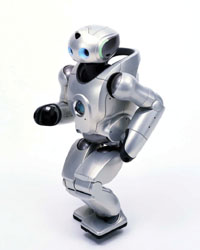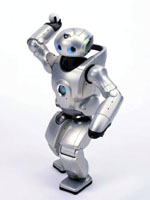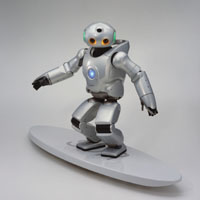Upfront: Will Your PC be a Bot?
Back to Contents of Issue: June 2004
|
|
|
|
by Tony McNicol |
|
 The folks at Sony have picked a new name for their SDR series of humanoid robots: Qrio, an abbreviation of "quest for curiosity." The robot's autumn debut last year was accompanied by a huge advertising push. But consumers are not yet able to satisfy their own curiosity: The company is keeping mum on plans to sell.
For now, Sony is keeping Qrio busy as it's "corporate ambassador," which is why two big round LED-lit eyes peer out at the public from posters and TV screens across Japan. Qrio has probably been on more business trips than the average company CEO -- everywhere from China to the US to Europe. Like Sony's robot pooch Aibo, Qrio is the brainchild of Sony's Entertainment Robot Company. And just like doting parents everywhere, Sony has been providing regular updates to the global media on their progeny's development.
A handful of journalists gathered in central Tokyo a few months ago to watch Sony demonstrate "the world's first running robot." Until recently, walking robots have relied upon "zero movement point" technology, where a robot shifts its weight from one foot to the other, maintaining contact with the ground at all times. Since the definition of running requires periodically getting both feet off the ground at the same time, Sony has had to develop a new "running motion" technology.
During the demonstration, Qrio clumped noisily across a raised platform before doing a few standing jumps. He didn't have a graceful stride, but he was running, sort of. Sony says that the robot lifts a couple of millimeters off the ground during each running stride and one centimeter off the ground with each hop.
It was only a matter of time before Qrio tried his hand at Japan's most popular sport: baseball. His creators looked on proudly as Qrio pitched a small ball to the assembled reporters. Nothing to worry Hideki Matsui, but the throw was smooth and realistic enough to draw a few coos of admiration from the audience.
Sony manager Yoshihiro Kuroki confessed that they've yet to find ways to protect Qrio from a heavy fall. He could be in trouble if he trips up mid-jog, even at his present stately 0.52 miles per hour.
"Our first goal was to get him to run. Next we'll worry about what to do when he falls over."
Even if he isn't ready to cope with a high-speed fall, Sony engineer Tatsuzo Ishida says that Qrio was built to withstand a bit of rough and tumble from the beginning. "From the earliest stage we assumed that this robot would fall very easily and very often."
At the moment, Qrio can extend his arms to protect himself when he falls forward. If he senses he's going to hit the deck sideways (dangerous for the elbow joints), he is able to twist his hips to cushion the impact.
Ishida says they would have made Qrio a little smaller if that had been technologically feasible. A smaller Qrio would have been easier to carry -- and perhaps a little less likely to dent your furniture if he falls over. "Our original plan was [to build a robot] 30 to 50 centimeters high."
The present Qrio is 58cm tall. Ishida suggests that a consumer version of Qrio would have to be smaller, lighter, safer and perhaps more robust. It looks like technological obstacles and safety concerns may have pushed back Qrio's sales debut; so if you yearn to buy a Sony android, you'll probably have to wait a while. Until quite recently, it seemed like Sony was planning to market their robot; even hinting that it could cost as much as a luxury car. But, in the wake of falling Aibo sales, the company may be reconsidering sales plans.
Still, even if Qrio is just a "technology platform," as Sony has recently begun saying, the company is trying hard to dress him up as a saleable product. He uses Sony Memory Sticks to hold his control program, and Sony says that its ultimate aim is to integrate the robot with other products. One humanoid-robotics expert who spoke to JI suspects that Sony may even be working on a smaller, cheaper version of Qrio to market in the near future.
At the moment, it's not that you couldn't buy a walking robot if you wanted to; it's just that there is little to choose from between simple children's toys and budget-busting research robots. Parents and gizmo fans might pay $50 for a novelty toy. But unless you are a robotics researcher, you are unlikely to fork out tens of thousands of dollars for a complicated and fragile piece of technology that doesn't actually do all that much.
Tokyo-based ZMP is one company that is trying to cover the expensive research robot end of the market. Among their bipedal research robots for sale and rental, their main product is the PINO robot, the newest version of which costs $45,000. PINO was originally created by the Kitano Symbiotic Systems Project, a government-funded research group looking at the parallels between biological and mechanical systems.
The project's director, Hiroaki Kitano, is also the director of Sony's Computer Science Laboratories, Inc. When the research group's humanoid robotics project ended in September 2003, they passed on the technology to ZMP, who are now selling and developing PINO and other robots from the project.
Along with Sony's Qrio and Honda's Asimo, the pointy-nosed PINO is becoming well-known in Japan. In 2001, PINO appeared as pop star Hikaru Utada's date in one of her music videos. Toy versions of PINO, with the same appearance but simplified mechanisms, are produced and sold by Tsukuda Original Co. for between JPY2,000 and JPY20,000.
ZMP is obviously betting on the eventual materialization of a larger market for their products. But while technological and economic reality may be making the home-android a sci-fi dream for now, ZMP is banking on Japan's very real cultural affection for people-like machines.
Mitsuo Kawato is the director of the Advanced Telecommunications Research Institute International. For five years now, he has been proposing the creation of an "Atom Boy project."
"We think that, with at least $500 million a year for 20 to 30 years, we can build a humanoid robot comparable to a 5-year-old child."
The project takes its name from Osamu Tezuka's well-known Atom Boy (see JI, April 2003) manga character, known as Astro Boy outside of Japan. Kawato believes that the project, involving as many as 500 scientists, could be the Japanese equivalent of the Apollo moon project in the US: a way of uniting the country in pursuit of a great goal, not to mention a perfect diversion from cultural and economic gloom. Instead of putting an American on the moon, the Atom Boy endeavor would put a robotic child in Japanese homes.
"If we would really like to have a big market for humanoid robots in the home, in shops and on the streets," Kawato says, "then we need general purpose intelligent humanoid robots."
Back at the Sony Entertainment Company, Ishida believes that someday Qrio is going to be one of the family. Ishida points out that Qrio can recognize around 22,000 words (though without necessarily deciphering what they mean). He can also learn the faces of 10 different people and recall information about them.
"He has to remember father, mother and the other members of the family," says Ishida. "The fact that he remembers you is part of the entertainment function."
Ishida hopes Qrio will eventually be included in an ongoing project to link all of Sony's home products. He says it's all about the exchange of information. "Most of our products deal with information. If one product gets some information, then the other products should be able to use that. Qrio could connect to the Internet, he could control a TV. Maybe he could communicate with Aibo."
Perhaps this is where Qrio's language functions could really come in handy? "It's definitely easier to interact with a robot than a computer screen, especially for elderly people who may not be able to use a computer easily. My dream is to see a robot replace the PC." @ |
|
Note: The function "email this page" is currently not supported for this page.


 Since Qrio was conceived as a family robot, Sony will have to ensure he doesn't cause anyone else harm, not just be able to survive a few knocks himself. The actuators (motors to move robotic joints) in Sony's Aibo are relatively feeble, but Qrio needs considerably more power to heft his 7kg around. That's why Qrio has sheet sensors in his joints to prevent him from trapping little fingers. And, a bit like an errant kitten, he is designed to go limp immediately if picked up by the handle on his neck.
Since Qrio was conceived as a family robot, Sony will have to ensure he doesn't cause anyone else harm, not just be able to survive a few knocks himself. The actuators (motors to move robotic joints) in Sony's Aibo are relatively feeble, but Qrio needs considerably more power to heft his 7kg around. That's why Qrio has sheet sensors in his joints to prevent him from trapping little fingers. And, a bit like an errant kitten, he is designed to go limp immediately if picked up by the handle on his neck.
 The company's other main product is Morph, a 38cm humanoid robot, one of the smallest in development. The robot is only available for rental at the moment, but ZMP is hoping to sell Morph alongside PINO at some time in the future.
The company's other main product is Morph, a 38cm humanoid robot, one of the smallest in development. The robot is only available for rental at the moment, but ZMP is hoping to sell Morph alongside PINO at some time in the future.



